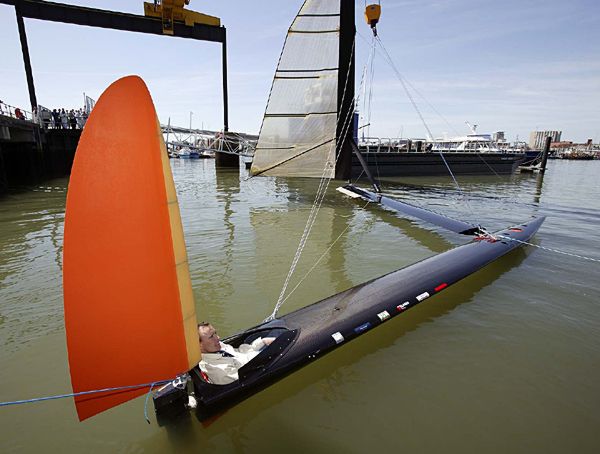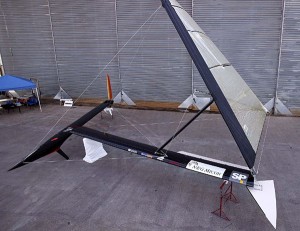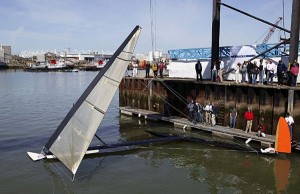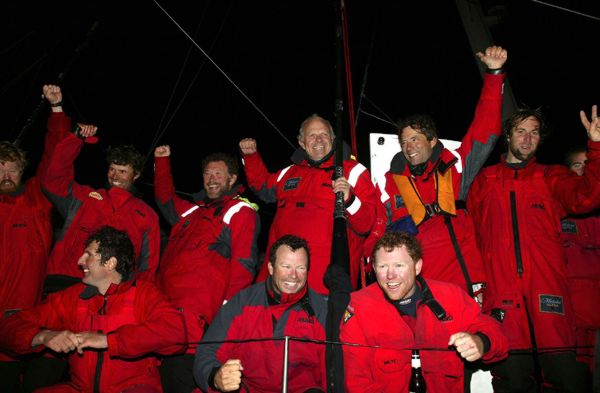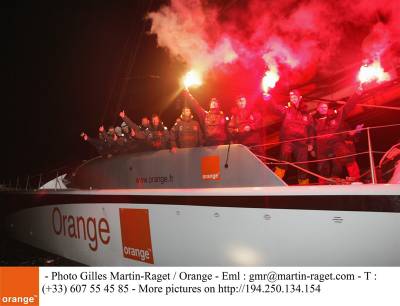Sailrocket: The Ultimate Ride to smash Sailing's World Speed Record
Sailrocket takes aim at the outright sailing speed record
April 26, 2004
Weighing in at just 170 kgs, the speed sailing craft Sailrocket didn't strain the launching crane when it was set into the Itchen River in England on April 24. This bizarre craft has been designed and built with just one purpose in mind: the outright world record for speed under sail. That record is current held by the Australian built "Yellow Pages Endeavour" at 46.52 knots, set in October 1993. The World Sailing Speed Record Council oversees records; their rule for the outright speed record calls for the average speed over a 500 meter course.
Sailrocket's objective is to raise the world record to the magic and elusive target of 50 knots. Along the way, it will break new ground in aerodynamics and composite construction; the trickle-down from this technology to "normal" sailcraft will be almost as exciting as the boat itself.
In conventional monuhulls and multihulls the leverage of the sail force is countered only by a weight/buoyancy leverage. This results in a very definite limits to stability in both the roll and pitch directions. Many speed record attempt designs suffer from the 2 principal side effects of this limitation - limited drive force and unsteady response to gusts.
Sailrocket employs a wholly different concept (first documented by Bernard Smith in the 1960s') in which the sail and keel elements are positioned so that there is virtually no overturning moment and no net vertical lift. When used correctly this concept results in a boat which no longer has obvious stability limits and in which the only significant response to gusts is a change in speed!
At speed Sailrocket rides on 2 tiny planing surfaces under the slender fuselage. The leeward float flies just above the surface supported by aerodynamic lift in 'ground effect'. The sail loading is reacted by single inclined hydrofoil emerging from the? forward planing surface.?
Steering is by means of an inclined surface piercing rudder operated by the single pilot situated at the aft end of the fuselage.
Control and performance characteristics have been extensively studied with a 1:5 scale radio controlled model.
The Team
Paul Larsen: Pilot and promotions
32 year old Australian born country boy Paul Larsen has a history of sailing some of the wildest and fastest boats ever to grace the oceans. He has always sailed multihulls but tasted real speed when delivering the 86 foot Commodore Explorer to Japan with Skip Novak. Paul stayed onboard as crew for the successful? 1998 Trans-Pacific attempt to San-Francisco with Bruno Peyron. Inspired, Paul left Oz in search of bigger and faster boats still. This quest lead him through 60 foot trimarans to Pete Goss and the revolutionary Team Philips upon which he crewed until its untimely demise. On the morning of 'The Race', a non-stop, no rules round the world race in maxi-multihulls he joined Tony Bullimore on Legato for a very longand difficult circumnavigation. An Atlantic attempt followed as did success in the double handed Transat-Jacque Vabre race to Brasil in 2001 with former Team Philips crew member Alex Bennett. Early in 2002 Paul joined Tracy Edwards Maiden II campaign for a successful record breaking season which included the cross-channel, Round Britain and Ireland and to Paul, Ultimately the outright 24 hour record where as watch-leader and helmsman he was part of the team that covered 694.7 miles in a single day at an astonishing average of just under 29 knots. A speedsailing highlight in anyone's books.
Malcolm Barnsley: Designer and project leader
45 year old Southampton based Naval Architect Malcolm Barnsley is currently senior test engineer with NEG-Micon Rotors which is a world leader in wind driven power technology. Malcolm is no stranger to speedsailing and has a long history involving 5 previous projects. Sailrocket is the culmination of all he has learnt and by far the most dedicated project to date. Malcolm has been working on Sailrocket for over three years and done extensive model testing. The desire to design and build the fastest yacht in the world has been burning for a long time and Malcolm can see no reason why the Sailrocket project won't allow this dream to be realised.
Richard Pemberton: Foil design and development
Richard Pemberton, 26, is currently a Ph.D. student in the School of Engineering Sciences at the University of Southampton.?
His research covers the fields of Computational Fluid Dynamics (CFD) and Statistical Modelling. He studied Ship Science in both Southampton and Hamburg as an
undergraduate, and has worked in the CFD department of the Hamburg Ship Model Basin.
He has co-built a hydrofoiling trimaran for Weymouth Speed
Week and regularly sails J24's and 505's
Nick Barlow: Composite structure design and construction
Nick has extensive experience of designing building wingmasts and high performance boats in composite materials, having run his own successful business in this field for 10 years.
Chris Hornzee Jones: Mechanical design and control systems
Chris is a highly respected consultant having recently engineered shows in the Millennium Dome and developed novel designs in wind turbine technology. He has also worked for Lotus on carbon fibre bicycle development.
Andy Bellamy: Composite construction design
Andy is a Composites Research and Development for NEG Micon Rotors Ltd and works with Malcolm Barnsley. Before that he completed a BSc (Hons) in Yacht Manufacturing and Surveying at the Southampton Institute. As well as designing boats, he likes to do a bit of sailing now and again (!) on a Mumm 36 and a Corby 45.
Main design particulars:
| Overall length | 10.0m |
| Overall beam | 8.5m |
| SailArea | 21.8m2 |
| Sailing weight | 235kg |
Follow Sailrocket's progress at www.sailrocket.com
For information on sailing speed records see www.sailspeedrecords.com
